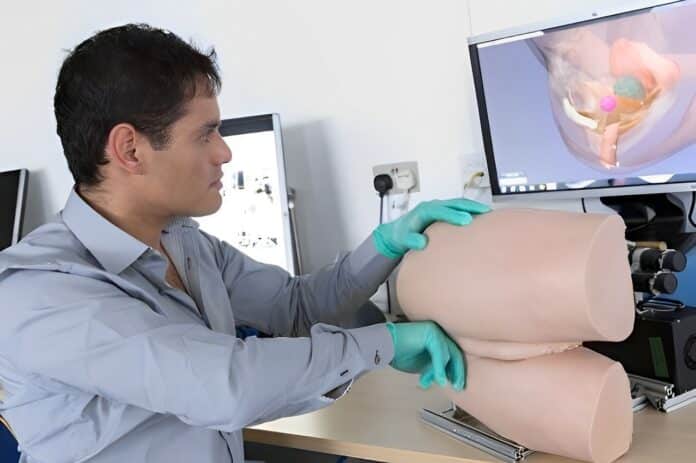Scientists at Imperial College London have developed the latest technology known as a robotic rectum. This latest technology contains prosthetic buttocks and rectum with inbuilt robotic technology.
It allows the doctor and medical students to perform the real rectal exam. It also gives results on their examination technique. Scientists have decided to use this technology for taking gynecological exams.
It has small robotic arms. This robotic arm forces the silicon rectum to delight the shape and feel of the back passage.
Rectal exams are essential for treating diseases like prostate cancer. A rectal exam is a primary test used for identifying a prostate-related problem. In the exam, place your index finger into the patient’s anus. It is essential to feel the walnut-sized prostate gland that sits below the bladder.
According to analysis, in the UK, there are almost one out of eight men is suffering from prostate cancer.
Dr. Fernando Bello, from the Department of Surgery and Cancer at Imperial College London, explains, “Normally, prostate cancer makes the patient feel hard and knobbly. But it is quite difficult to explain how exactly this cancerous prostate feels. Inner tests are really challenging to learn and to teach. Because the examinations occur in the body, the trainer cannot see what the trainee is doing, and vice versa. Additionally, doctor rarely gets the chance to practice the examination, as few patients would volunteer as practice subjects. In fact, there is only one person registered in the country as a test subject, called a Rectal Teaching Assistant (RTA) in the UK.”
“The outcome of these examinations has various suggestions for patients. This can be used for a diagnosing disease like prostate cancer”, he then said.
Currently, plastic models are used for testing. But these models have a drawback in that they do not allow to feel like living skin and tissue. Therefore, with the purpose of helping doctors and nurses, scientists have created a robotic ‘trainer rectum’. This guides doctors as well as nurses that how to perform the examination. It also makes sure that the patient is not feeling discomfort.
A doctor can insert his finger inside a silicone thimble by using the trainer. The silicone thimble is attached to robotic technology and can recreate the same sensation as the human rectum. A computer screen behind the device can also display a 3D model of the rectum and prostate.
It allows the doctor to see the dissection while they examine it with the help of 3D glasses. This technology has another advantage; one can program it for a different scheme by changing the anatomy each time.
Dr. Alejandro Granados, the lead researcher, said, “We scanned different volunteers with an MRI scan and used this to perfect the shape and geometry of the anatomy. We asked many doctors and nurses – including prostate specialists and cancer surgeons for the trial of this technology. They commented on the great advantage of being able to alter the anatomy. Each person has a different size and shape of the rectum and prostate and it increases from person to person. This technology enables doctors to practice their skills in many different virtual patients. They also observed these examinations are performed solely by feel, experiencing a realistic sensation is crucial.”
By collecting data from real prostate examinations in patients, a team tries to make it more perfect.
According to Dr. Bello, “There is only small research exists for testing exact pressure and trajectory which doctors need for the prostate exam. That’s why, scientists asked doctors to wear a small pressure sensor on their fingertip, inside the surgical glove, when they are treating real patients.”
Using finger pressure sensors and 3D software on traditional plastic models will be the best option for improving current training facilities.
Dr. Bello added: “Haptics is the technology which is currently being used to identify the sensation of touch and how to integrate this into electronic devices. It has large suggestions for the field of medicine. For example, virtual reality technology doing progress at a rapid rate. But haptics is also important, otherwise, the point of immersing yourself in a virtual role if you can’t feel and interact with it will be worthless”
He said, “However, other high-tech prosthetic rectum have been developed, but none of them have incorporated complex haptic technology. They allow for detailed feedback to the doctor performing the examination. Previous models have had a few pressure sensors placed inside a model rectum, but none have provided the type of 3D modelling and detailed touch feedback available with this technology.”
